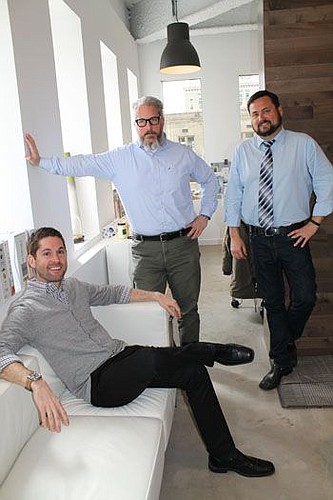
Don’t use the “M” word to describe the architectural style of Content Design Group.
Modern is almost a four-letter word in Jacksonville, they say, a place with many historical buildings and fans of the same.
The company’s three partners also avoid the “G” word.
Green building is synonymous with “expensive,” they say. Educated buyers already want green features when shown how they pay off.
The real idea behind Content Design Group is simply to design well.
“Everything we do is well considered,” said partner James Blythe. “When you walk in, you have a feeling it’s something you can understand, instead of it being something that someone else felt was a good idea in the past.”
Modern and green, however, are the quickest ways to describe the team’s renovation of the JAX Chamber, the transitional look of neo-urban eateries like Bold Bean Coffee Roasters or the design of TerraWise’s net-zero solar-paneled home in Cedarbrook, a Northside subdivision that came online last month.
One of Jacksonville’s newest and edgiest design companies, Content Design Group was forged out of friendship, a shared vision of building and an economic downturn that forced outside-the-box thinking.
The three partners — Blythe, Greg Beere and Jason Fisher — came into the company with degrees in design and architecture and experience in architecture and residential, commercial, and LEED building.
Opened by Beere in 2008, Fisher, a work buddy, joined soon after. The team built Content Design through the recession by working any kind of project they could get — porch additions, summer kitchens, carports.
When clients were few, they spent their extra time imagining new looks for Jacksonville. They took photos of their favorite buildings, created renderings of the renovation possibilities and posted them to their website.
When Fisher’s friend, Blythe, came on a few years later, they expanded into commercial projects. They did office and restaurant build-outs, but it was the renovation of the JAX Chamber that put the team on the building industry’s map.
It also illustrated the designers’ take on modern design.
Modern can be about the aesthetic of a building, but it’s also about lifestyle, Beere said.
“Our goal is when we design a space is that every square foot functions well and the people living in it are successful.” he said. “We happen to like modern because we think it’s honest.”
For the chamber building, the partners interviewed employees and learned the organization today helps small businesses, not just multimillion-dollar companies. So, they replaced plaster walls with translucent ones — a feature that enables privacy, but also shows activity.
“You walked in there before and it was like a ship’s hull,” Beere said. “Now, it’s not like walking into a scary place. There’s a vibrancy.”
They included training rooms with web-enabled screens and a first-floor café.
When it comes to designing homes, economy of space and honesty in design also apply.
For their Cedarbrook model, they removed the standalone living and dining rooms — spaces that aren’t used today. Instead, there’s a loft above the kitchen, where kids can play separately, but within earshot of adults.
“Sometimes when you look at spec-built house plans, it just looks like people literally just added, added, added,” Blythe said. “So you end up with these McMansions, where nobody was ever told no.”
Their Cedarbrook home stands out for its solar panel option. But, energy-efficient design, even without solar panels, is a choice that pays, the team said.
A higher SEER (seasonal energy efficiency ratio) air conditioner can recapture the $1,200 extra upfront cost in one or two years. Low-VOC paints emit fewer fumes and don’t cost any more than traditional paint.
Aerated and low-flow plumbing fixtures save money on water bills, and Energy Star appliances come with a label that estimates annual operating costs.
One problem with “green,” Beere said, is it’s become an overused buzzword. “It was, ‘Yes we’re green.’ But (builders) were not quantifying that in any particular way,” he said.
Talking about value leads customers naturally to energy-efficiency.
“It’s smart, so why would you waste money?” Beere said. “You don’t need to be a tree hugger or environmentalist. We realized high-quality building was the same thing is building green.”
(904) 356-2466